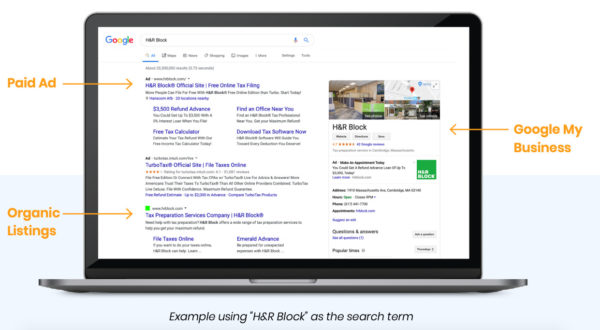
A keystone represents the most important element of any strategy. For a professional services firm, one of the keystones of their digital marketing strategy should undoubtedly be search engine optimization, known more commonly as “SEO.”
SEO is the process of making your website, and your brand, more attractive to search engines. In earlier posts, we discussed content marketing as a foundation for a strong SEO program.
In addition to the strong on-page content that a robust content marketing program can provide, there are additional nuances and strategies to consider when planning and executing your company’s SEO strategy.
Search engines like Google prioritize technical factors of website construction and performance just as highly as on- and off-page content. In this article, I’ll break down what matters when it comes to showing up on Google’s search engine results page.
The first step is usually the hardest to take
Your search engine optimization strategy should initially be implemented during your website build. Counterintuitively, your website build should come after you’ve already laid out your digital marketing strategy. My digital marketing agency, Solutions for Growth, always undertakes an in-depth strategy analysis before jumping into the development of marketing tools.
TIP: Need help defining your digital marketing strategy? Check out The Download, our free online marketing guide for professional services businesses.
Search engines, mainly Google and Bing, factor in elements like page load speed, clean and efficient code, and the readability of the website’s page structure and content into their rankings.
SEO can be equally technical and creative, calling on a team effort to be successful. Many practices prefer to use a full-service agency that specializes in professional services marketing to handle their search engine optimization, as it often requires skill sets and resources outside the scope of their knowledge. But there are some basic SEO practices you can start implementing yourself right away if you’re looking to get started.
Next, we’ll discuss the three major elements of a respectable SEO strategy: technical SEO, on-page content, and off-page content.
Technically speaking
As major search engines are responsible for most online traffic, they want to ensure that they direct their users to the most qualified websites for their inquiry.

Before they can even reach the content they seek, the website must load efficiently. Photos and graphics should be optimized for fast loading but should retain their clarity.
Web elements that require large amounts of data download, like automatic video players or detailed infographics, may be better used on internal pages. Including these “heavy” elements on your homepage can negatively impact your page load speed, and thus, your search ranking.
Thereafter, the site must be structured so that the average internet user knows where to find information. As an example, you will rarely find websites with side-menus on the first page of Google’s search results. That is because website best practices have since pivoted to the top menu layout that we, as users, are now accustomed to.
It’s also important to make sure your site is secure, especially if you are transmitting personal or payment information through your web server. SSL (Secure Socket Layer) is the current standard for web security, encrypting data through multiple layers and channels. Most website builder tools and hosting companies include SSL in their hosting plans, but it is important to make certain.
On (the same) page
I previously authored a blog post focused primarily on content marketing and its place in a digital marketing strategy. Along with technical SEO, on-page content is a foundational requirement. Without well-developed content, Google will not know what kind of information you are offering to their user base, thus will not recommend you as a resource.
Once you are certain that your website is up to snuff with the nuts and bolts of technical SEO, it is time to enact a plan to make your website the go-to location for internet users searching using keywords related to your business.
Keywords are the catalyst for all things sought and found on the internet. They are words and short phrases that are embedded in your web content. These keywords allow Google and other search engines to “crawl” or index your website for subject matter, and rank it appropriately.
Many search engine users approach web search differently, some asking questions and others using short phrases in their queries, these word strings are made up of keywords. In turn, search engines match your content with the users’ search query and provide them with a list of the internet’s best options.
In putting together your website, you will be writing new text and developing new content for the internal web pages (those that require a click or two to see, in contrast to your homepage, which users see as soon as they arrive at your website). In doing so, it’s important to place an emphasis on using keywords in the text on those pages that you want to be found for in the digital marketplace.
Be liberal with your usage of these important words and phrases. Google’s indexing robots and your reader should find it equally useful. Sometimes this requires toeing the line between writing for robots and writing captivating pieces that “speak the language” of your target market.
Some general guidelines while writing on-page SEO content for professional services are:
- Use a minimum of 500 words in your article, 1,000 – 2,000 words is ideal.
- Your prioritized keyword should appear in the title as well as in the first paragraph, then throughout the article as often as it sounds natural.
- Use keyword synonyms within the article. For example, use “accountant” and “CPA”
- Hyperlink to other internal website articles or pages that are relevant to the subject.
- Make sure the content is original. Google will penalize unoriginal content.
Off-page content: The unsung hero
We call off-page content an unsung hero because off-page content does plenty of heavy lifting, but stays out of the spotlight. You see, in order to qualify as off-page content, it must be held on another website’s server.
A popular example of off-page content is the development of inbound links. These links connect back to your website from another website on the internet. The more trusted that website is, the more clout by association you receive. By search engine logic, if a popular website has already been vetted and links back to your site, the search engine can assume that your site is to be trusted.
Other off-page SEO includes a robust social media presence, active and updated web listings, press releases, and even articles written by you and posted on major websites (such as the article you are reading now).
Sustainable SEO
Unlike Google Ads or other pay-per-click services, you cannot flip a switch and turn off your SEO program. One major advantage of SEO though is that it doesn’t require an influx of cash to be effective.
Quality SEO programs follow thoughtful and well-laid-out plans for future content development. Many organizations use content creation calendars and regular website maintenance to gain ground or maintain their positions atop the hill on the search engine results page.
Like most programs, if you do not nurture your SEO program, it will fizzle out. However, content creation and sticking to a calendar is free. Particularly for professional services, keyword-rich content is of special importance, since their expertise is of more interest to searchers. So with determination, your business can build and maintain a search engine lead funnel that doesn’t quit until you do.




